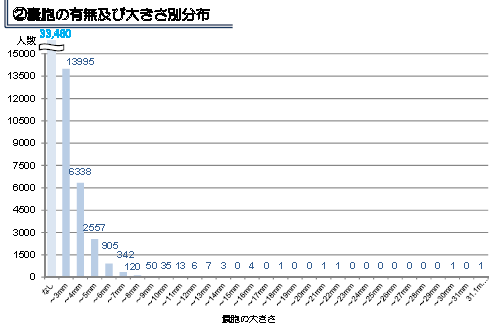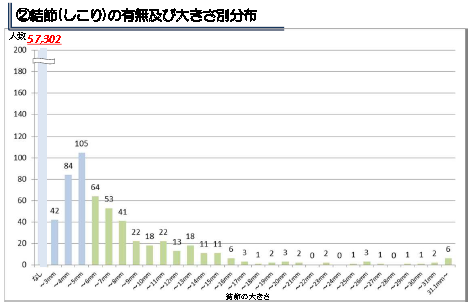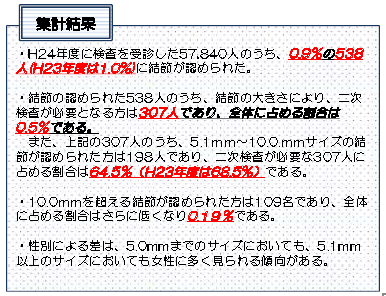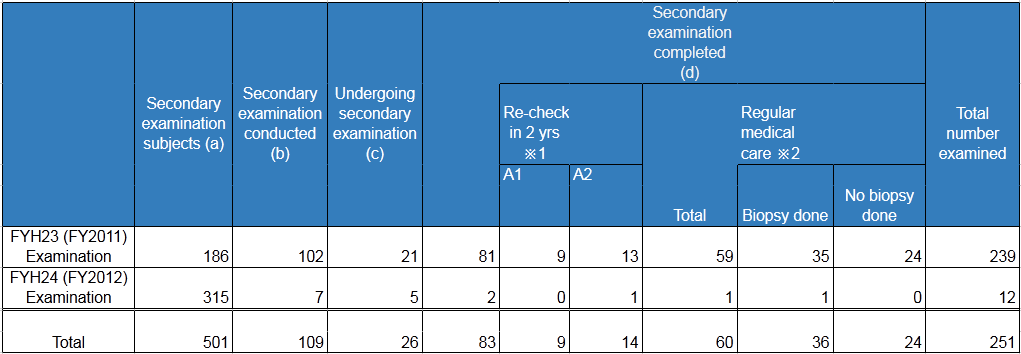The Ninth Report of Fukushima Prefecture Health Management Survey was released on November 18, 2012.
The thyroid examination section of the survey is shown in this link.
http://www.pref.fukushima.jp/imu/kenkoukanri/241118koujyousen.pdf
It contains new thyroid examination results from August 25, 2012 through September 28, 2012, added to the previous results from the first five months of Fiscal Year Heisei 24 (FYH24), from April 1 through August 24, 2012. Up to November 1, 2012, 76,357 of eligible 89,662 children underwent the examination in FYH24.
The results up to September 28, 2012 revealed that 24,682 (42.7%) of 57,840 children had thyroid ultrasound abnormalities. Together with 38,114 children (13,645 or 35.8% had thyroid ultrasound abnormalities) tested in the last half of Fiscal Year Heisei 23 (FYH23) from October 2011 through March 2012, a total of 38,327 (39.9%) of 95,954 Fukushima children have been found to have ultrasound abnormalities.
Most significantly, there was a child, a female in the 16 to 18 age group, with a C assessment in the new results, requiring an immediate secondary examination. This was the first time there was a C assessment.
Even though the percentage of abnormalities from FYH24 at 42.7% was slightly less than the previous report at 43.1%, the overall abnormalities remain essentially the same at 40%. Moreover, there are higher proportions of nodules over 10.1 mm than the increase in the total number of children examined. As before, a higher proportion of abnormalities was seen in female children in all age groups in the A2 assessment and in age groups older than 6 in the B assessment.
******
Consideration was given to increase the number of children who could be examined by offering the examination for grade school and junior high school students at schools where the children attend . In addition, public venues with good traffic access were chosen as the examination sites.
As there are over 155,000 children eligible to undergo the examination in FYH24, efforts were made to structure a more effective and efficient examination system so that the examination implementation period may be shortened:
● Try to obtain a facility where 700 to 800 may be examined per day.
● In actually implementing the examination, manage the sensitivity of the equipment in order to achieve an examination with high standards. Attempt to examine 700 to 800 children by structuring a more effective reception and guidance.
Moreover, as of November 1, 2012, the thyroid examination began at facilities outside Fukushima Prefecture for those children who have evacuated Fukushima.
*****
FYH24 (FY2012) implementation schedule includes the following municipalities:
September to early October 2012: 18,061 children from Nihonmatsu, Motomiya and Otama.
Early to mid October 2012: 4,757 children from Koori, Ten-ei, and Kunimi.
Mid October to late November 2012: 14,655 children from Shirakawa, Nishigo and Izumizaki.Early October 2012 to late March 2013: 64,478 children from Koriyama.
Mid January 2013 to late March 2012: 3,139 children from Miharu-machi, the only municipality whose residents were administered stable iodine prophylaxis.
*****
Note:
H23 refers to Heisei Year 23, which is the same as 2011.
FYH23 refers to Fiscal Year Heisei 23 which runs from April 1, 2011 through March 31, 2012.
H24 refers to Heisei Year 24, which is the same as 2012.
FYH24 refers to Fiscal Year Heisei 24 which runs from April 1, 2012 through March 31, 2012.
*****
For a complete English translation of the thyroid examination section of the Sixth and Seventh Reports of Fukushima Prefecture Health Management Survey, please refer to these links.
http://fukushimavoice-eng.blogspot.com/2012/07/thyroid-examination-by-fukushima.html
https://docs.google.com/file/d/0B68f83tqq7QuZUdCZXhTLVl2dEE/edit?pli=1
For an excerpted English translation of the thyroid examination section of the Eighth Report of Fukushima Prefecture Health Management Survey, please refer to this link.
http://fukushimavoice-eng.blogspot.com/2012/09/fukushima-thyroid-examination-part-2.html
*****
The Ninth Report of Fukushima Prefecture Health Management Survey (excerpt)
November 18, 2012
Summary of Thyroid Examination Results ①


[Explanation of assessment classifications]
・A1 and A2 will be observed until the next round of examinations (after FYH26 or FY2014).
・B and C will undergo secondary examination. (Notice of the date and place of the secondary examination will be sent to them).
※A2 will be treated as B if the thyroid gland condition warrants the need for a secondary examination.
※Examination results for FYH24 (FY2012) include completed results up to September 28, 2012.
※Some cases have both nodules and cysts.
*********
Summary of Thyroid Examination Results ②
1. Distribution by age and gender for each assessment classification category.
(For each category the left column shows the number of boys, the middle column shows the number of girls, and the right column shows the total, based on age groups in five-year intervals.)
The upper table is for FYH23 (FY2011). The lower table is for FYH24 (FY2012), which shows the completed results up to September 28, 2012.

2. Proportion of each assessment classification category by age.
In the tables of horizontal bar graphs, the left table is for boys and the right for girls. For each age group, in five-year intervals, the top bar shows FYH23 (FY2011) and the bottom bar FYH24 (FY2012).

*********
Details of Thyroid Examination Results (FYH24 Exam: Cysts)

① Size breakdown of cysts found at thyroid examination conducted in FYH24 (FY2012)
※1 Assessment classification based on the size of the cysts alone.
※2 The reason the size group “~3.0 mm” is put together with “No cysts present” in the proportion is because in ordinary medical examination cysts smaller than 3.0 mm are treated as no cysts.
② Size distribution of cysts
Total Results
●Of 57,840 who were examined in FYH24 (FY2012), 33,460 or 57.8%(64.9% in FYH23) had no cysts.
In addition, cysts equal to or smaller than 3.0 mm are considered not to be cysts in ordinary medical examinations, and 13,995 had cysts equal to or smaller than 3.0 mm.
These two groups comprised 47,455 or 82.0% (83.3% in FYH23) of the total examined.
● Difference by gender was barely seen up to 3.0 mm and over 10.1 mm, but the incidence in girls tended to be higher in sizes between 3.1 mm and 10.0 mm.
Difference by age groups showed cysts up to 3.0 mm were seen most frequently in the age 6-10 group, with incidence gradually decreasing with increasing age.
*********
Details of Thyroid Examination Results (FYH24 Exam: Nodules)
① Size breakdown of nodules found at thyroid examination conducted in FYH24 (FY2012)
② Size distribution of nodules
Total Results
●Of 57,840 who were examined in FYH24 (FY 2012), 538 or 0.9% (1.0% in FYH23) had nodules.
●Of 538 who had nodules, 307, or 0.5% of the total examined, had nodules large enough to require secondary examination.
In addition, 198 of the 307 mentioned above had nodules which were 5.1 mm to 10.0 mm in size, comprising 64.5% (68.5 in FYH23) of the 307 requiring secondary examination.
●109 had nodules which were larger than 10.0 mm, and its proportion was even lower at 0.19% of the total examined.
●Difference by gender showed a tendency for more girls in both nodules up to 5.0 mm and larger than 5.1 mm.

*********

■Summary of Secondary Thyroid Examination (All-prefecture Preliminary Examination)
1. Examination implementation policy
● If lumps (nodular lesions) are found during the primary thyroid examination, then a secondary examination (detailed ultrasound examination, blood test, urine test, biopsy if needed) will be conducted at Fukushima Medical University Hospital.
● A2 will be treated as B and secondary examination implemented if the thyroid gland condition warrants the need for secondary examination.
● Those qualifying for secondary examination will be notified of the time and place of the secondary examination at a later date by the Fukushima Medical University Radiation Medicine Prefecture Health Management Survey Center.
● Notification for the secondary examination is provided in the order the primary examination was done, but a priority is given for the implementation of the secondary examination to those who are considered to require an early examination.
● Results of the secondary examination will be directly explained to those examined.
● Locations will be established outside Fukushima Medical University for the secondary examination by the end of this fiscal year.
■ Schedule Plan of Secondary Thyroid Examination (All-prefecture Preliminary Examination)
FYH23 examination: 186 qualified.
Conducted from March 2012 to the end of November 2012.
102 already had more than one examination.
FYH24 examination: 315 qualified.
Currently being conducted.
Includes those who completed the primary examination by September
28, 2012. (Priorities are given as needed).
Fukushima-city residents will have the secondary examination
implemented before March 2013.
■ Implementation status of secondary thyroid examination (All-prefecture preliminary examination). (As of November 5, 2012)

※1 Those who will be re-checked at the standard examination after April 2014 due to the absence of abnormalities.
※2 Those who have moved onto regular medical care schedule, to be re-checked mostly 6 months to one year later.
The thyroid examination section of the survey is shown in this link.
http://www.pref.fukushima.jp/imu/kenkoukanri/241118koujyousen.pdf
It contains new thyroid examination results from August 25, 2012 through September 28, 2012, added to the previous results from the first five months of Fiscal Year Heisei 24 (FYH24), from April 1 through August 24, 2012. Up to November 1, 2012, 76,357 of eligible 89,662 children underwent the examination in FYH24.
The results up to September 28, 2012 revealed that 24,682 (42.7%) of 57,840 children had thyroid ultrasound abnormalities. Together with 38,114 children (13,645 or 35.8% had thyroid ultrasound abnormalities) tested in the last half of Fiscal Year Heisei 23 (FYH23) from October 2011 through March 2012, a total of 38,327 (39.9%) of 95,954 Fukushima children have been found to have ultrasound abnormalities.
Most significantly, there was a child, a female in the 16 to 18 age group, with a C assessment in the new results, requiring an immediate secondary examination. This was the first time there was a C assessment.
Even though the percentage of abnormalities from FYH24 at 42.7% was slightly less than the previous report at 43.1%, the overall abnormalities remain essentially the same at 40%. Moreover, there are higher proportions of nodules over 10.1 mm than the increase in the total number of children examined. As before, a higher proportion of abnormalities was seen in female children in all age groups in the A2 assessment and in age groups older than 6 in the B assessment.
******
Consideration was given to increase the number of children who could be examined by offering the examination for grade school and junior high school students at schools where the children attend . In addition, public venues with good traffic access were chosen as the examination sites.
As there are over 155,000 children eligible to undergo the examination in FYH24, efforts were made to structure a more effective and efficient examination system so that the examination implementation period may be shortened:
● Try to obtain a facility where 700 to 800 may be examined per day.
● In actually implementing the examination, manage the sensitivity of the equipment in order to achieve an examination with high standards. Attempt to examine 700 to 800 children by structuring a more effective reception and guidance.
Moreover, as of November 1, 2012, the thyroid examination began at facilities outside Fukushima Prefecture for those children who have evacuated Fukushima.
*****
FYH24 (FY2012) implementation schedule includes the following municipalities:
September to early October 2012: 18,061 children from Nihonmatsu, Motomiya and Otama.
Early to mid October 2012: 4,757 children from Koori, Ten-ei, and Kunimi.
Mid October to late November 2012: 14,655 children from Shirakawa, Nishigo and Izumizaki.Early October 2012 to late March 2013: 64,478 children from Koriyama.
Mid January 2013 to late March 2012: 3,139 children from Miharu-machi, the only municipality whose residents were administered stable iodine prophylaxis.
*****
Note:
H23 refers to Heisei Year 23, which is the same as 2011.
FYH23 refers to Fiscal Year Heisei 23 which runs from April 1, 2011 through March 31, 2012.
H24 refers to Heisei Year 24, which is the same as 2012.
FYH24 refers to Fiscal Year Heisei 24 which runs from April 1, 2012 through March 31, 2012.
*****
For a complete English translation of the thyroid examination section of the Sixth and Seventh Reports of Fukushima Prefecture Health Management Survey, please refer to these links.
http://fukushimavoice-eng.blogspot.com/2012/07/thyroid-examination-by-fukushima.html
https://docs.google.com/file/d/0B68f83tqq7QuZUdCZXhTLVl2dEE/edit?pli=1
For an excerpted English translation of the thyroid examination section of the Eighth Report of Fukushima Prefecture Health Management Survey, please refer to this link.
http://fukushimavoice-eng.blogspot.com/2012/09/fukushima-thyroid-examination-part-2.html
*****
The Ninth Report of Fukushima Prefecture Health Management Survey (excerpt)
November 18, 2012
Summary of Thyroid Examination Results ①
[Explanation of assessment classifications]
・A1 and A2 will be observed until the next round of examinations (after FYH26 or FY2014).
・B and C will undergo secondary examination. (Notice of the date and place of the secondary examination will be sent to them).
※A2 will be treated as B if the thyroid gland condition warrants the need for a secondary examination.
※Examination results for FYH24 (FY2012) include completed results up to September 28, 2012.
※Some cases have both nodules and cysts.
*********
Summary of Thyroid Examination Results ②
1. Distribution by age and gender for each assessment classification category.
(For each category the left column shows the number of boys, the middle column shows the number of girls, and the right column shows the total, based on age groups in five-year intervals.)
The upper table is for FYH23 (FY2011). The lower table is for FYH24 (FY2012), which shows the completed results up to September 28, 2012.

2. Proportion of each assessment classification category by age.
In the tables of horizontal bar graphs, the left table is for boys and the right for girls. For each age group, in five-year intervals, the top bar shows FYH23 (FY2011) and the bottom bar FYH24 (FY2012).
*********
Details of Thyroid Examination Results (FYH24 Exam: Cysts)
① Size breakdown of cysts found at thyroid examination conducted in FYH24 (FY2012)
※1 Assessment classification based on the size of the cysts alone.
※2 The reason the size group “~3.0 mm” is put together with “No cysts present” in the proportion is because in ordinary medical examination cysts smaller than 3.0 mm are treated as no cysts.
② Size distribution of cysts
Total Results
●Of 57,840 who were examined in FYH24 (FY2012), 33,460 or 57.8%(64.9% in FYH23) had no cysts.
In addition, cysts equal to or smaller than 3.0 mm are considered not to be cysts in ordinary medical examinations, and 13,995 had cysts equal to or smaller than 3.0 mm.
These two groups comprised 47,455 or 82.0% (83.3% in FYH23) of the total examined.
● Difference by gender was barely seen up to 3.0 mm and over 10.1 mm, but the incidence in girls tended to be higher in sizes between 3.1 mm and 10.0 mm.
Difference by age groups showed cysts up to 3.0 mm were seen most frequently in the age 6-10 group, with incidence gradually decreasing with increasing age.
*********
Details of Thyroid Examination Results (FYH24 Exam: Nodules)
① Size breakdown of nodules found at thyroid examination conducted in FYH24 (FY2012)
② Size distribution of nodules
Total Results
●Of 57,840 who were examined in FYH24 (FY 2012), 538 or 0.9% (1.0% in FYH23) had nodules.
●Of 538 who had nodules, 307, or 0.5% of the total examined, had nodules large enough to require secondary examination.
In addition, 198 of the 307 mentioned above had nodules which were 5.1 mm to 10.0 mm in size, comprising 64.5% (68.5 in FYH23) of the 307 requiring secondary examination.
●109 had nodules which were larger than 10.0 mm, and its proportion was even lower at 0.19% of the total examined.
●Difference by gender showed a tendency for more girls in both nodules up to 5.0 mm and larger than 5.1 mm.
*********
Implementation Status of FYH24 (FY2012) Secondary Thyroid Examination
■Summary of Secondary Thyroid Examination (All-prefecture Preliminary Examination)
1. Examination implementation policy
● If lumps (nodular lesions) are found during the primary thyroid examination, then a secondary examination (detailed ultrasound examination, blood test, urine test, biopsy if needed) will be conducted at Fukushima Medical University Hospital.
● A2 will be treated as B and secondary examination implemented if the thyroid gland condition warrants the need for secondary examination.
● Those qualifying for secondary examination will be notified of the time and place of the secondary examination at a later date by the Fukushima Medical University Radiation Medicine Prefecture Health Management Survey Center.
● Notification for the secondary examination is provided in the order the primary examination was done, but a priority is given for the implementation of the secondary examination to those who are considered to require an early examination.
● Results of the secondary examination will be directly explained to those examined.
● Locations will be established outside Fukushima Medical University for the secondary examination by the end of this fiscal year.
■ Schedule Plan of Secondary Thyroid Examination (All-prefecture Preliminary Examination)
FYH23 examination: 186 qualified.
Conducted from March 2012 to the end of November 2012.
102 already had more than one examination.
FYH24 examination: 315 qualified.
Currently being conducted.
Includes those who completed the primary examination by September
28, 2012. (Priorities are given as needed).
Fukushima-city residents will have the secondary examination
implemented before March 2013.
■ Implementation status of secondary thyroid examination (All-prefecture preliminary examination). (As of November 5, 2012)
※1 Those who will be re-checked at the standard examination after April 2014 due to the absence of abnormalities.
※2 Those who have moved onto regular medical care schedule, to be re-checked mostly 6 months to one year later.

No comments:
Post a Comment